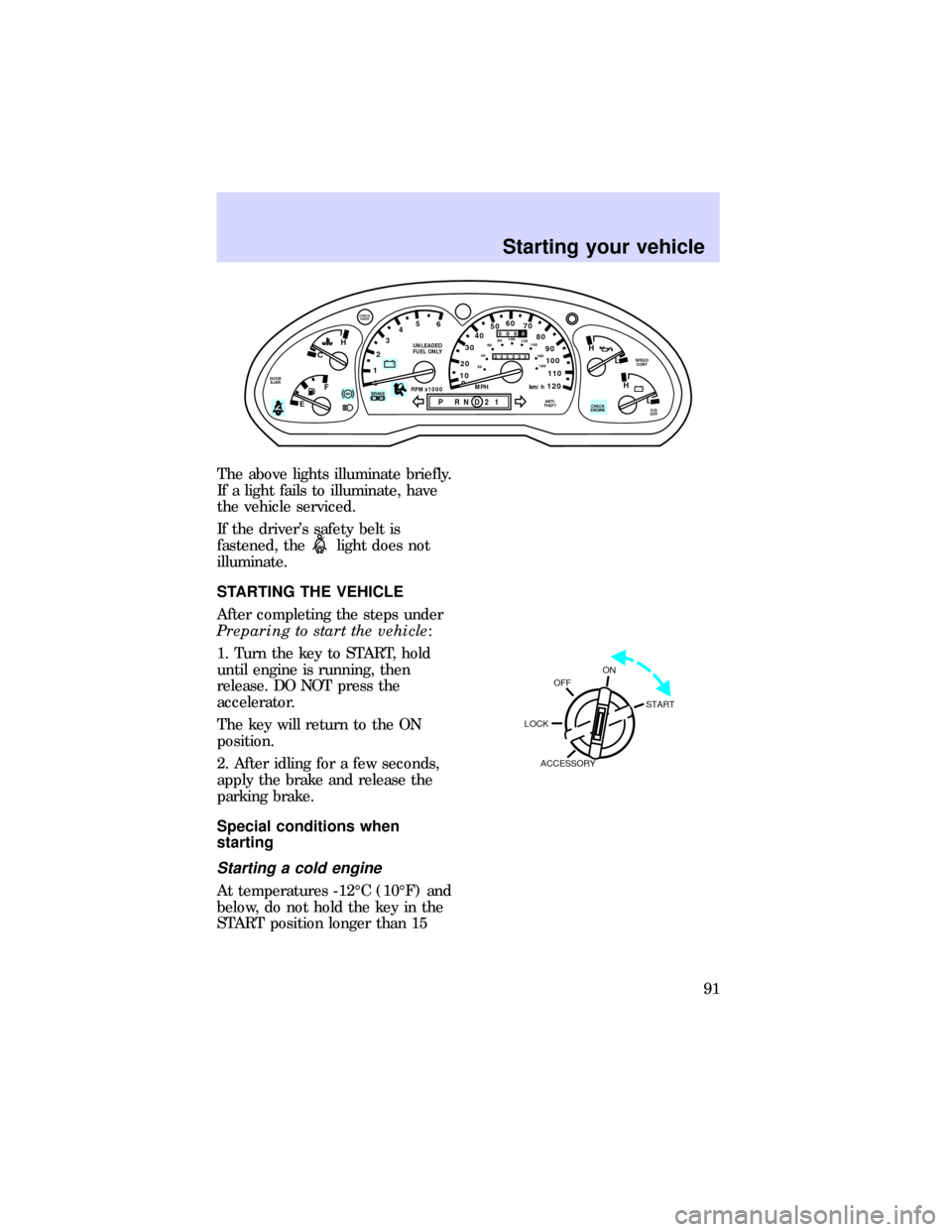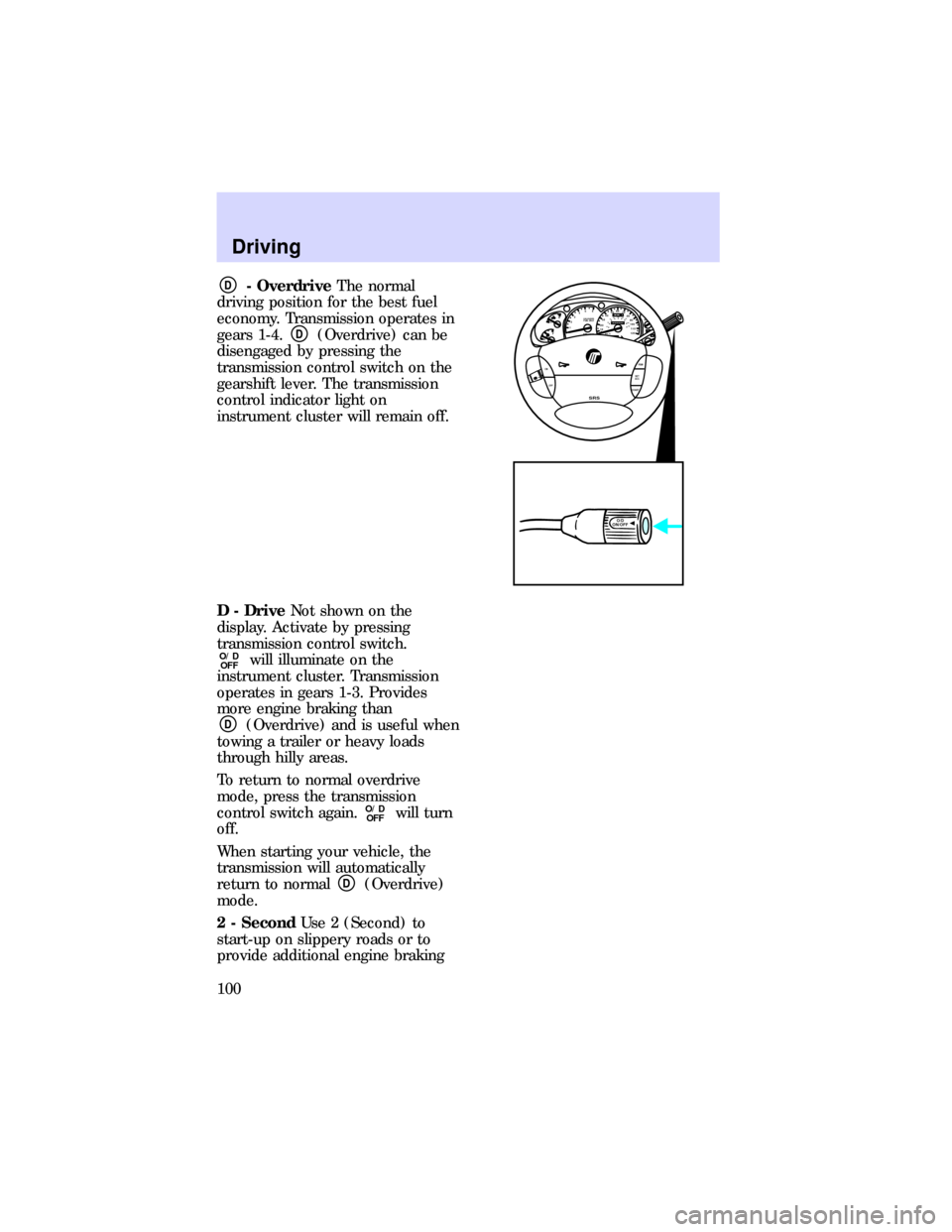engine Mercury Mountaineer 1997 s User Guide
[x] Cancel search | Manufacturer: MERCURY, Model Year: 1997, Model line: Mountaineer, Model: Mercury Mountaineer 1997Pages: 197, PDF Size: 2.08 MB
Page 55 of 197

When installing new batteries, be
sure to place the positive (+) side
down as marked. Snap the two
halves back together.
Replacing lost transmitters
If a transmitter is lost, take your
vehicle's transmitter to the dealer
to have the remote entry system
deprogrammed for the lost
transmitter. This will prevent
unauthorized use of the lost
transmitter.
You can purchase additional
transmitters (up to four can be
used) from your dealer. Use the
following instructions to
re-program the key fobs.
Re-programming your key
fob(s)
1. Insert key into ignition.
2. Rotate key to ON five times. DO
NOT START THE ENGINE. Keep
key in ON position the fifth time.
Locks will lock/unlock by
themselves.
3. Push UNLOCK on first key fob.
Doors will lock/unlock to indicate
key fob has been programmed.
4. Repeat Step 3 for each key fob
to be re-programmed.
5. Turn ignition key to OFF. Verify
each transmitter has been
programmed by activating any
button.
Controls and features
55
Page 58 of 197

Delayed accessory
Delayed accessory provides power
to operate the power windows and
power moon roof (if equipped) for
10 minutes after the ignition
switch is turned to OFF.
If either front door is opened
during the 10 minute period the
delayed accessory feature is
disabled.
Battery saver
Battery saver is a feature that
automatically shuts off power to
these lights after 40 minutes: glove
box, engine compartment,
overhead console, mirror, courtesy
and interior lamps.
Battery saver prevents the battery
from being drained if these lights
are left on or if a door is not
completely closed. Battery power
is restored if the remote entry
transmitter is used, any door is
opened, the liftgate is opened, or
ignition key is turned to ON.
Controls and features
58
Page 89 of 197

IMPORTANT SAFETY
PRECAUTIONS
Extended idling at high
engine speeds can produce
very high temperatures in the
engine and exhaust system,
creating the risk of fire or other
damage.
Do not park, idle, or drive
your vehicle in dry grass
or other dry ground cover. The
emission system heats up the
engine compartment and exhaust
system, which can start a fire.
Do not start your vehicle
in a closed garage or other
enclosed area. Never sit in a
stopped vehicle for more than a
short period of time with the
engine running. Exhaust fumes
are toxic. SeeGuarding against
exhaust fumeslater in this
chapter for more instructions.
PREPARING TO START YOUR
VEHICLE
Before starting the vehicle:
1. Make sure all vehicle occupants
have buckled their safety belts.
Refer to theSeating and safety
restraintschapter for more
information.
Starting your vehicle
89
Page 91 of 197

The above lights illuminate briefly.
If a light fails to illuminate, have
the vehicle serviced.
If the driver's safety belt is
fastened, the
light does not
illuminate.
STARTING THE VEHICLE
After completing the steps under
Preparing to start the vehicle:
1. Turn the key to START, hold
until engine is running, then
release. DO NOT press the
accelerator.
The key will return to the ON
position.
2. After idling for a few seconds,
apply the brake and release the
parking brake.
Special conditions when
starting
Starting a cold engine
At temperatures -12ÉC (10ÉF) and
below, do not hold the key in the
START position longer than 15
0ABS
- +
P RND21
UNLEADED
FUEL ONLY
RPM x 1000
12345
6
- +
H
H
L L
ANTI-
THEFT
CHECK
ENGINE
O/D
OFF SPEED
CONT
H
C
F
E
!P
DOOR
AJAR
BRAKE
CHECK
GAGE
0
20
1030405060
70
80
90
110
120000000
oooo
100
20406080100
120
140
160
180
MPH km/h
ON
START
LOCK
ACCESSORYOFF
Starting your vehicle
91
Page 92 of 197

seconds. If the engine does not
start on the first attempt:
1. Turn the ignition key to LOCK
and wait approximately 10
seconds.
2. Try starting the engine again.
At temperatures above -12ÉC
(10ÉF), do not hold the key in the
START position longer than five
seconds. If the engine does not
start on the first attempt:
1. Turn the ignition key to LOCK
and wait approximately five
seconds.
2. Try starting the engine again.
Starting a warm engine
Do not hold the key in the START
position for longer than five
seconds. If the engine does not
start on the first attempt:
1. Turn the ignition key to LOCK
and wait a few seconds until the
starter stops.
2. Try starting the engine again.
Starting the engine after two
failed attempts (warm or cold)
If the engine does not start after
two attempts:
1. Turn the key to LOCK and wait
about two minutes.
Starting your vehicle
92
Page 93 of 197

2. Press the accelerator all the way
to the floor and hold.
3. Turn the key to START. Release
it once the engine starts.
4. Release the accelerator
gradually as the engine speeds up.
If the engine still does not start,
refer toFuel pump shutoff
switchin theRoadside
emergencieschapter.
Engine block heater (if
equipped)
To prevent electrical
shock, do not use your
engine block heater with
ungrounded electrical systems or
two-pronged (cheater) adapters.
Engine block heaters are strongly
recommended if you live in a
region where temperatures reach
-23ÉC (-10ÉF) or below. An engine
block heater works by warming the
engine coolant. This improves
engine starting by warming the
engine faster. Engine block heater
operation also allows the heater
and defrost system to respond
more quickly than usual.
Starting your vehicle
93
Page 95 of 197

Ventilating your vehicle
²If the engine is idling while the
vehicle is stopped in an open
area for long periods of time,
open the windows at least 2.5
cm (1 inch). Adjust the heating
or air conditioning to bring in
fresh air.
²Improve vehicle ventilation by
keeping all air inlet vents clear
of snow, leaves and other debris.
OFF
A/C
MAX
A/C
U
AUTO
L DOOR LOCK
Starting your vehicle
95
Page 100 of 197

D- OverdriveThe normal
driving position for the best fuel
economy. Transmission operates in
gears 1-4.
D(Overdrive) can be
disengaged by pressing the
transmission control switch on the
gearshift lever. The transmission
control indicator light on
instrument cluster will remain off.
D - DriveNot shown on the
display. Activate by pressing
transmission control switch.
O/D
OFFwill illuminate on the
instrument cluster. Transmission
operates in gears 1-3. Provides
more engine braking than
D(Overdrive) and is useful when
towing a trailer or heavy loads
through hilly areas.
To return to normal overdrive
mode, press the transmission
control switch again.
O/D
OFFwill turn
off.
When starting your vehicle, the
transmission will automatically
return to normal
D(Overdrive)
mode.
2 - SecondUse 2 (Second) to
start-up on slippery roads or to
provide additional engine braking
0P RND21
UNLEADED
FUEL ONLY
RPM x 100012345
6H
C
F
E
RSM
SET
ACC
COAST OFF ON
SRS
- +H
H
L L020
1030405060
70
80
90
110
120000000oooo
km/h100
20406080100
120
140
160
180
O/D
ON/OFF
Driving
100
Page 101 of 197

on downgrades. Transmission
operates in gears 1-2.
1 - LowUse 1 (Low) to provide
maximum engine braking on steep
downgrades. Upshifts can be made
by shifting to 2 (Second) or to
D(Overdrive). Selecting 1 (Low)
at higher speeds causes a shift to 2
(Second), and will shift to 1 (Low)
after vehicle decelerates to the
proper speed.
Brake-shift interlock
This vehicle is equipped with a
brake-shift interlock feature that
prevents the gearshift from being
moved from P unless the brake
pedal is depressed.
If you cannot move the gearshift
out of P with the brake pedal
depressed:
1. Apply the parking brake.
2. Turn ignition key to LOCK, then
remove the key.
3. Insert the key and turn to OFF.
4. Apply brake pedal and shift to N
(Neutral).
5. Start the vehicle.
If it is necessary to use the above
procedure to move the gearshift, it
is possible that a fuse has blown
and the vehicle's brakelamps may
not be operating properly. Refer to
Fuses and relaysin theRoadside
emergencieschapter.
Driving
101
Page 105 of 197

that could damage drive
components.
If the transmission and transfer
case are submerged in water, their
fluids should be checked and
changed, if necessary.
All rear axle lubricants must be
replaced every 160,000 km
(100,000 miles) or if the axle has
been submerged in water.
Otherwise, check the lubrication of
the rear axle according to the
intervals in theService Guide.
Driving on hill or slope terrain
When driving on a hill, avoid
driving crosswise or turning on
steep slopes. You could lose
traction and slip sideways. Drive
straight up, straight down or avoid
the hill completely. Know the
conditions on the other side of a
hill before driving over the crest.
When climbing a steep hill, start in
a lower gear rather than
downshifting to a lower gear from
a higher gear once the ascent has
started. This reduces strain on the
engine and the possibility of
stalling.
When descending a steep hill avoid
sudden braking. Rapid pumping of
the brake pedal will help slow the
vehicle and still maintain steering
control.
When speed control is on and you
are driving uphill, your vehicle
speed may drop considerably,
especially if you are carrying a
Driving
105